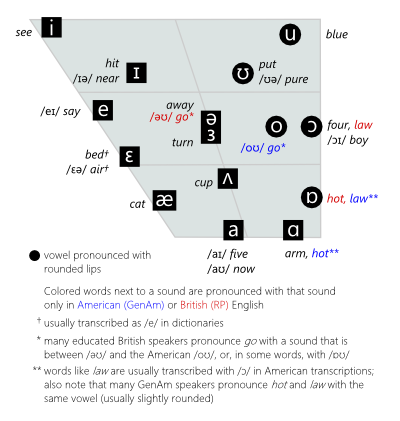I needed to find an online vowel chart for English, but I couldn’t find one I liked, so I made one myself. Here it is: English vowel chart
The Antimoon Blog
Thoughts for serious language learners

-
Language help
You can select any word on this page to check its definition and pronunciation in a dictionary. In addition, if you see colored text, you can click it (or point at it) for a pop-up explanation.
-
About
My name is Tomasz P. Szynalski. I live in Poland. In the 1990s, my friend and I taught ourselves to speak English fluently (with a native-like American accent) in about 3 years, using some unorthodox learning techniques. In 2001, we founded Antimoon to share our insights with other English learners.
-
Recent Posts
- Reader mail: Reading aloud to improve your English3.1
- Grammar rules update4.7
- Why it’s so difficult to speak English without mistakes3.4
- Things you should know about phonetic transcription1.29
- English pronunciation is a minefield11.1
- Why it’s important to learn about the sounds of English10.24
- Modernizing Antimoon10.16
- YouGlish: A YouTube-based pronunciation dictionary2.19
- Antimoon en español12.12
- Confusing American phonetic transcriptions for “air”, “near” and “sure”8.20
- Should you care about phonetic transcriptions?6.26
- Solving the problem of typing foreign characters and phonetic symbols on a PC5.14
-
Archives
© Tomasz P. Szynalski

Thanks for the chart, very nice indeed. Regarding General American pronunciation and using the IPA system, is LDCE the most accurate dictionary out there?
Yes, I believe so.
Just checked a LDCE for Advanced Learners and it uses /e/ for bed instead of the correct /ɛ/.
One more thing, the chart distinguishes the openness of /ɑ/ and /ɒ/ by placing /ɒ/ higher with respect to /ɑ/, why is that? According to Wikipedia both have the same level of openness.
The whole idea of the chart is that it shows the position of ENGLISH vowels, not cardinal vowels.
Are you saying that the English ɒ is not exactly the same as the cardinal vowel ɒ? My understanding is that English features both cardinals ɑ and ɒ, and both are the same except that ɒ rounds the lips. Being that the case, ɑ and ɒ should be at the same horizontal level, otherwise I would think that ɒ is near-open rather than open according to the chart.
Please correct me if I am wrong or missing something.
In BrE, /ɒ/ (hot) is certainly not cardinal. In AmE, /ɒ:/ (law) can be pronounced in a variety of ways, but usually closer to /ɒ:/ than /ɔ:/. If I were making a chart for AmE only, I would put it a bit lower. I didn’t want to overcomplicate the chart by placing separate markers for British and American /ɒ/. They would have to be very close to each other.
There are other compromises like this in the chart.
In the end, a chart will never tell you what your ears will. If you want to know exactly how Americans pronounce /ɒ:/, listen to Americans instead of studying charts.
BTW, discussions at this level of detail quickly become pointless, as there is no universally-agreed-upon definition of cardinal vowels. Just listen to these three recordings of /ɒ/ by three eminent phoneticians (Wells, Samsaran, Ladefoged). Do they sound the same to you?
http://www.phonetics.ucla.edu/course/chapter1/wells/chart28.wav
You are right. Thanks for taking the time to answer.
An interesting and useful chart.
When you say the vowel is “more closed”, shouldn’t you say the vowel is “closer”. As far as I know, “close” refers to the fact that the tongue rises towards the hard palate, thus getting closer to it.
Are both terms used interchangeably ?
You may be right, technically. But if the opposite is “open”, isn’t it logical to say “closed”?
Tom, what other words like “law” are pronounced with ɔ in AmE?
The chart doesn’t say that “law” is pronounced with /ɔ/ in AmE.
Correct question: what other words like “law” are pronounced with /ɒ/ in AmE?
BTW, please have a look at this chart:
http://en.wikipedia.org/wiki/IPA_chart_for_English_dialects#Chart
Do you think a new row should be added to the table on the right?
thought, caught, all
Thank you, Tom. It seems that /ɔ/ is used before ‘r’, e.g. “door”, “four”; /ɒ/ is used in all other words.
The following article about the Cot–caught merger is also interesting:
http://en.wikipedia.org/wiki/Phonological_history_of_English_low_back_vowels#Cot.E2.80.93caught_merger
Thank you very much for posting this good content! I am looking forward to checking out more!
Thank you very much for your effort .really this chart helps me a lot in under standing vowels.